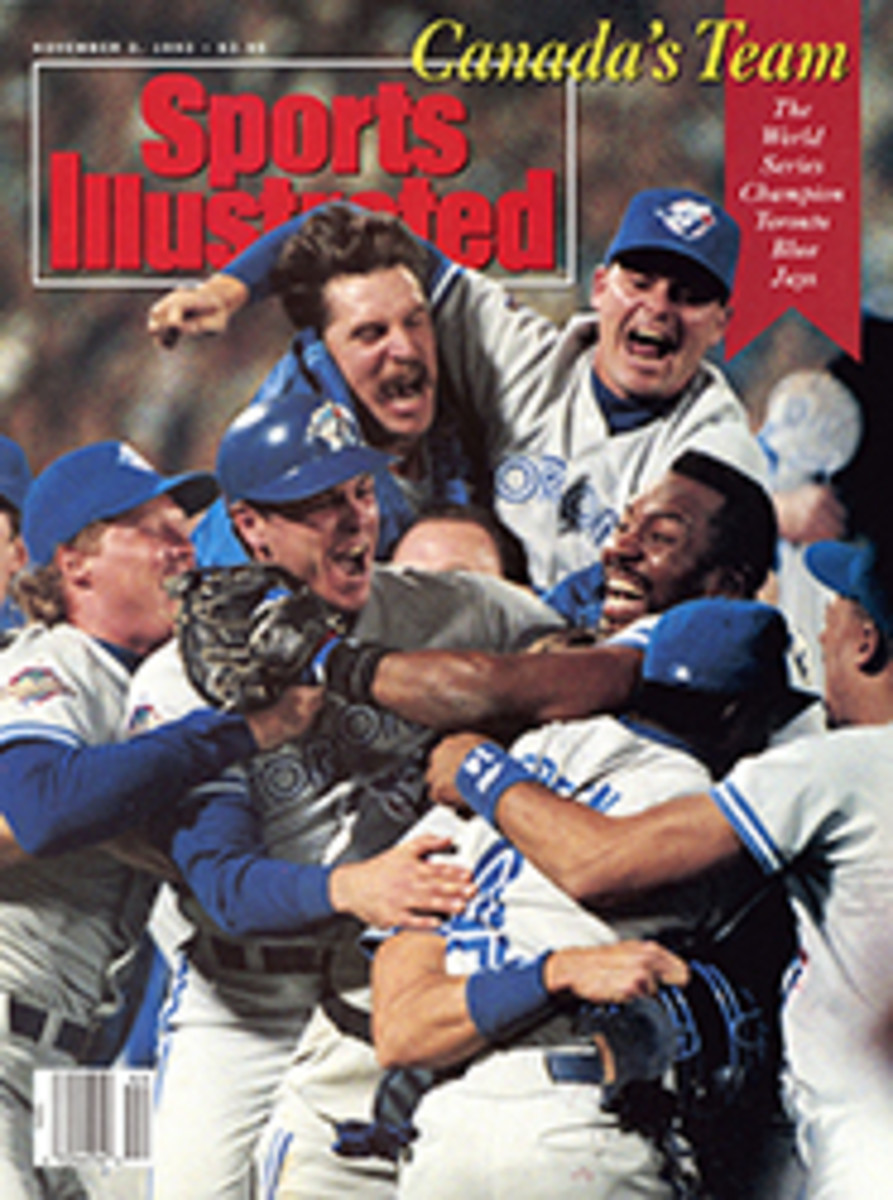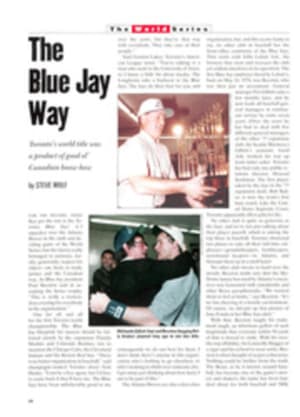
SCORECARD
The National Passètime
The World Series was a true fall classic, loaded with drama that turned on good pitching and timely hitting. We bring this up only because there's a very good chance you were watching one of those riveting Ross Perot infomercials on another channel. CBS, which paid $1.06 billion in 1989 for the right to televise baseball for the next four years—apparently mainly to promote The Hat Squad and Knots Landing—had the second-lowest ratings ever for a World Series following Game 5. That dismal news came after CBS had already written off a $500 million loss on baseball.
Then, even as baseball was winding up its showcase event last week, deputy commissioner Steve Greenberg revealed that ESPN has decided it would rather pay baseball $13 million not to have to carry its games than the $250 million it would have owed if it exercised its option. The buyout by ESPN, which will lose an estimated $240 million on its four-year deal with baseball, may be a bargaining ploy. But executives from all three broadcast networks told baseball's television committee last week to expect a huge decrease in rights fees in their next contract. Jon Mandel, a senior vice-president at Grey Advertising, summed it up this way for The Wall Street Journal: "There is nothing special about baseball anymore."
The marriage between TV and sports has been rocky for some time. Anticipating that things may get worse, NFL commissioner Paul Tagliabue asked his league's owners to accept an extension of their current network contracts at much lower fees. The owners refused, and Barry Frank, a veteran negotiator of TV rights fees, predicts they "will be very sorry they did not accept the adjustment and extension."
For baseball, a decline in TV money will make it harder for teams to meet their enormous payrolls. The owners will either have to hold the line on salaries or find new ways to attract TV viewers, perhaps by introducing interleague play or expanding the playoffs. "The reality is that we aren't entering into any more agreements where we lose money," Howard Stringer, No. 2 man at the CBS Broadcast Group, told USA Today last week. "I don't want to repeat the pain of these last four years. Driving off a cliff isn't our intention."
The Men of Blew
Two years ago baseball stopped assigning umpires for postseason play on a rotation basis—a scheme that ensured that if you were an ump and breathing, you'd get to work a World Series—and went to a merit system. Well, sort of. "We look at the guys who we think are due to work an event," says Marty Springstead, the executive director for umpiring in the American League, "and choose from among that basic pool on the merits of the season they've just had." In other words, any halfway decent umpire who hasn't done a Series recently could still get picked.
As the umpiring in this year's Series showed, the new system isn't much better than the old one. Of the six umps selected, three were working their first Series, three had one Series apiece under their belts, and none were crew chiefs. There were two obviously blown calls: American League ump Mike Reilly called the Toronto Blue Jays' Roberto Alomar out at the plate in Game 2, but replays showed Alomar was easily safe; and National League ump Bob Davidson missed a tag at second that would have given the Jays the first Series triple play since Bill Wambsganss's unassisted one for the Cleveland Indians in 1920. At least Davidson had the grace to say, "I thought I was correct at first, but then I saw the pictures, and I had to admit I probably missed it."
Some of the umpires in the Series were very good, but some is not enough. The best teams in baseball deserve the best umpires, even if it means some of the same guys popping up every year.
And while we're at it, baseball should consolidate its umpiring corps, eliminating league designations even during the regular season. That would go a long way toward establishing a clearly uniform strike zone. The inconsistency of ball and strike calls at the World Series is an annual annoyance. The situation should be addressed by the commissioner.
Oh, that's right. There is no commissioner.
Not So Fast
In our Sept. 28 issue we reported that the University of Washington football team had 27 players who run 40 yards in a time of 4.6 seconds or faster. Tailback Beno Bryant, we said, turns a 4.29 in the 40, cornerback Waller Baileya 4.31, and star running back Napoleon Kaufman a blistering 4.22. "Nobody runs with Napoleon," said overawed Husky freshman Jason Shelley. Well, apparently not even Napoleon runs with Napoleon.
The Washington coaching staff certified the times as correct, having begun timing recruits themselves after receiving exaggerated times from players' high school coaches. This is a fairly common practice. "I know one thing, every high school coach I've ever seen exaggerates his players' 40-yard-dash times," says Oklahoma strength and conditioning coach Pete Martinelli. "They want the kid to get signed."
Now comes an alert reader, Pat Crandall of Bowie, Md., to assert that virtually all 40 times dispensed by football coaches—swallowed whole and breathlessly reported by the press—are preposterous. Crandall notes that the 1991 world championship 100-meter final, in which Carl Lewis set the world record of 9.86, was videotaped and analyzed at 10-meter intervals by Seiko. By extrapolation, it can be proved to within one .01 of a second that Leroy Burrell, who was leading at that point and whose clocking of 9.88 at the finish is the second fastest ever in the event, had a time at the 40-yard mark of 4.38 seconds. Which would mean that those 40-yard times at Washington—and at a lot of other schools—are just plain nonsense.
Instant Loser
St. Louis Blue general manager Ron Caron invests a few dollars each week in the Illinois lottery, and while the Blues were in training camp last month, the jackpot for choosing the six winning numbers swelled to $42 million. When the winning numbers were selected on Oct. 3, Caron was pleased to see he had picked the first two, 7 and 8, and he began to get excited when he discovered he also had the next two numbers, 18 and 28.
The fifth number was 38, and Caron was beside himself when he found he had that one too. The final number was 17. Caron had picked 13.
The day after the lottery, one player, Denny Felsner, was cut from the Blues' training camp roster. Felsner's uniform number was 17.
The Ol' Redhead
Red Barber, who was 84 when he died last week in Florida, was only 31 when he began broadcasting Brooklyn Dodger games in 1939, but despite his youth he had an immediate impact on Brooklyn and on baseball. Big league teams had been on radio before, but daily play-by-play broadcasts were not considered an important part of baseball. Some clubs did not broadcast at all. New York City's three teams—the Dodgers, the Yankees and the Giants—even had an agreement not to put games on the radio, on the dubious premise that doing so would hurt ticket sales. Larry MacPhail, who took over in Brooklyn in 1938, scoffed at that idea and brought in Barber.
The Dodgers were a rising team, and Barber's vivid word pictures of their games delighted fans not just in Brooklyn but all over the New York area. His musical descriptions of an at bat were filled with crescendos, diminuendos and rests. For example, as Barber described a confrontation between Dodger slugger Dolph Camilli and St. Louis Cardinal pitcher Lon Warneke, you could almost hear the Ol' Redhead tap his baton.
"Dolph is not the biggest man in baseball, but there are none stronger," Barber drawled. "No, suh. They don't come stronger than Dolph Camilli. Down in training camp one time, some of the ballplayers went to visit a zoo. Hold it. Here's Warneke's pitch. A curve down low. There was a gorilla in the zoo, and Camilli got to staring at the gorilla, and the gorilla got to staring back at Dolph. A curve stays wide, ball two. And they're both a-lookin' at each other, and someone, I think it may have been Whit Wyatt...John Whitlow Wyatt of the North Georgia Wyatts, says, 'You know, I think Camilli could take him, hand to hand.' Hold it. Camilli swings! There's a high drive to right. It's way up there. Slaughter's at the base of the wall looking up, looking, but Enos can plumb forget this one. It's gone. Over the 344-foot sign. Number 16 for Dolph Camilli. Say, folks, I think Wyatt may have something there."
After Barber began broadcasting Dodger games, attendance in Ebbets Field shot up to record levels, and when Brooklyn won the National League pennant in 1941, the Dodgers were the most popular team in New York and, indeed, in the country. Barber had clearly demonstrated the importance to baseball of broadcasting. Radio, and later television, became as integral a part of the game as the batter's box.
Barber thought of himself as a reporter, not a showman or a shill. Despite his affection for Brooklyn and the Dodgers, he was never a homer. He had superb command of English, but he always spoke naturally on the air, lacing his rapid, precise descriptions of complex action with folksy, down-home Southern expressions that delighted his Northern audience.
He was a true professional who set standards of excellence that have been approached but never surpassed. Perhaps his finest monument is that the two other most-admired baseball broadcasters of the past 40 years—Vin Scully and Ernie Harwell—both broke into the major leagues working and learning under Red Barber.
—ROBERT CREAMER
PHOTO
Barber thought of himself as a reporter at the ballpark.
PHOTO
DAVIOSON: V.J. LOVERO
Davidson robbed the Jays of a triple play in Game 3.
PHOTO
KAUFMAN: PETER READ MILLER
Kaufman may be fast, but nobody's that fast.
They Said It
Bobby Brue, Senior PGA Tour player: "What's nice about our tour is you can't remember your bad shots."
Pat Williams, Orlando Magic general manager, on the riches realized by rookie Shaquille O'Neal: "Shaq's house is in such a great neighborhood, the bird feeders have salad bars."

